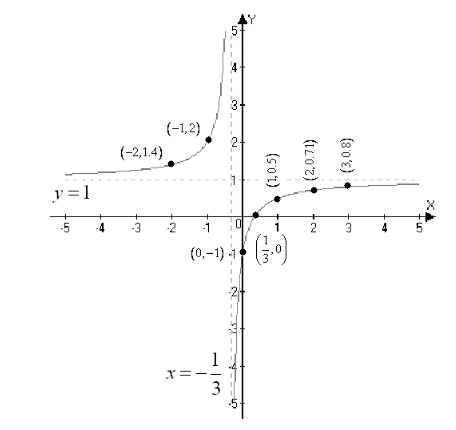
(a)
To find:The domain of function.
(a)
Answer to Problem 38E
The domain of function is all the real numbers except x=32 .
Explanation of Solution
Given information:
The function is f(x)=x2−3x−42x2+x−1
Calculation:
Consider the function.
. f(x)=6x2−11x+36x2−7x−3
Simplify the function.
f(x)=6x2−11x+36x2−7x−3f(x)=(2x−3)(3x−1)(3x+1)(2x−3)f(x)=(3x−1)(3x+1)
The function is valid for all the real numbers except x=32 and x=−13 .
Therefore, the domain of function is all the real numbers except x=32 and x=−13 .
(b)
To find:The intercepts.
(b)
Answer to Problem 38E
They- intercept is (0,1) and the x- intercept is (13,0) .
Explanation of Solution
Given information:
The function is f(x)=x2−3x−42x2+x−1
Calculation:
Put x=0 in function to find y-intercept.
f(0)=6(0)2−11(0)+36(0)2−7(0)−3f(0)=−1
Equate function to zero to find x intercept.
f(0)=0(3x−1)(3x+1)=03x−1=0x=13
Therefore, the y- intercept is (0,1) and the x- intercept is (13,0) .
(c)
To find:The asymptotes.
(c)
Answer to Problem 38E
The horizontal asymptote is y=1 and vertical asymptote is x=13 .
Explanation of Solution
Given information:
The function is f(x)=x2−3x−42x2+x−1
Calculation:
In given function degree of numerator is same as degree of denominator. The horizontal asymptote will be the ratio of leading coefficient of numerator and denominator which is 33=1 .
Equate denominator to zero to find vertical asymptote.
3x+1=0x=13
Therefore, the horizontal asymptote is y=1 and vertical asymptote is x=13 .
(d)
To find:The sketch of graph.
(d)
Answer to Problem 38E
The graph is shown in Figure-(1).
Explanation of Solution
Given information:
The function is f(x)=x2−3x−42x2+x−1
Calculation:
The below table shows the value of y corresponding to the value of x .
| x | −2 | −1 | 1 | 3 |
| f(x) | 1.4 | 2 | 0.5 | 0.8 |
Draw the sketch for the function by using the equations of asymptotes.

Figure-(1)
Therefore, the graph is shown in Figure-(1).
Chapter 2 Solutions
Precalculus with Limits
- quick solve thisarrow_forwardquick solve thisarrow_forwardThis table displays the current in equal intervals. Time t/ms 05 10 15 20 25 30 Current i/A 0 4.8 9.1 12.7 8.8 3.5 0 The formula for the charge as follows: 30x10-3 q 0 i dt Use formula to solve the current at 30ms using both the trapezoidal rule and Simpson's rule showing all steps and workingarrow_forward
 Calculus: Early TranscendentalsCalculusISBN:9781285741550Author:James StewartPublisher:Cengage Learning
Calculus: Early TranscendentalsCalculusISBN:9781285741550Author:James StewartPublisher:Cengage Learning Thomas' Calculus (14th Edition)CalculusISBN:9780134438986Author:Joel R. Hass, Christopher E. Heil, Maurice D. WeirPublisher:PEARSON
Thomas' Calculus (14th Edition)CalculusISBN:9780134438986Author:Joel R. Hass, Christopher E. Heil, Maurice D. WeirPublisher:PEARSON Calculus: Early Transcendentals (3rd Edition)CalculusISBN:9780134763644Author:William L. Briggs, Lyle Cochran, Bernard Gillett, Eric SchulzPublisher:PEARSON
Calculus: Early Transcendentals (3rd Edition)CalculusISBN:9780134763644Author:William L. Briggs, Lyle Cochran, Bernard Gillett, Eric SchulzPublisher:PEARSON Calculus: Early TranscendentalsCalculusISBN:9781319050740Author:Jon Rogawski, Colin Adams, Robert FranzosaPublisher:W. H. Freeman
Calculus: Early TranscendentalsCalculusISBN:9781319050740Author:Jon Rogawski, Colin Adams, Robert FranzosaPublisher:W. H. Freeman
 Calculus: Early Transcendental FunctionsCalculusISBN:9781337552516Author:Ron Larson, Bruce H. EdwardsPublisher:Cengage Learning
Calculus: Early Transcendental FunctionsCalculusISBN:9781337552516Author:Ron Larson, Bruce H. EdwardsPublisher:Cengage Learning





